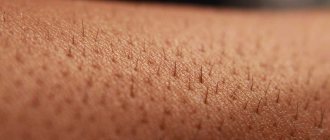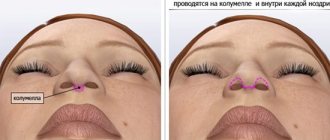Perhaps everyone is familiar with the situation when swelling occurs on the face. The reasons for this can be both diseases of the internal organs and a banal excess of water drunk the day before. And swelling on the face almost always occurs after surgery. It certainly doesn’t look aesthetically pleasing and worsens both a person’s mood and appearance, but fortunately, getting rid of swelling is quite easy.
Reasons for appearance
Any edema is the accumulation of excessive fluid in the tissues of the body. By creating increased pressure on the vessels and capillaries, the liquid penetrates through their walls into the tissues and muscles, saturating them, resulting in the formation of swelling.
There are two main causes of edema:
- accumulation of lymph in the area of tissue affected by the operation;
- postoperative inflammation.
In the first case, swelling is explained by natural causes: surgical intervention in the body’s functioning always leads to an increased load on the immune system, which strives to ensure the normalization of the body’s functioning and triggers increased formation of lymph. Lymph accumulates in the area of tissue damaged during surgery and causes swelling.
In the second case, the cause of edema is an infectious or inflammatory process. An exacerbation of a chronic disease caused by the operation, a cold, or non-compliance with the doctor’s recommendations in the postoperative period can cause swelling of the face after surgery. This is often accompanied by hyperemia (redness) and increased body temperature.
Although postoperative swelling on the face almost always occurs, it can have different severity. The degree of swelling depends on the following factors:
- the general condition of the immune system (the stronger the immune system, the weaker the signs of swelling will be, and the faster it will subside);
- individual characteristics of the patient’s health (are there any chronic diseases, a tendency to edema, hypertension, etc.);
- proper adherence to doctor’s recommendations, compliance with restrictions and precautions;
- lifestyle (presence of bad habits, addiction to alcohol, etc.).
As a rule, swelling does not occur immediately after surgery, but on the second or third day; depending on the efforts made, it will subside after several days, or less often, a week. If postoperative swelling persists into the second week, or if fever, chills, or intoxication are added to it, a visit to the doctor should not be postponed. In this case, at a minimum, antibacterial therapy is necessary.
The occurrence and removal of edema
The localization of postoperative edema is usually limited to a certain area surrounding the area of the body where surgery was performed. Surgical treatment of the lower extremities and pelvic organs practically causes swelling of the legs, incl. knee, foot and other parts. During the operation, the blood supply is disrupted, which provokes swelling, from which the joint suffers. In order to remove swelling, it is necessary to fully restore blood circulation.
The best way to treat problems in the knee or other areas is to use ointments (such as Lyoton) or gels. In principle, methods of treating the legs depend little on the location: similar means are used for both the knee and the foot. An important element in restoring joint functions is taking vitamin complexes and mineral components.
Men often experience such a very unpleasant phenomenon as swelling of the scrotum. A feature of this area is the multiple concentration of lymphatic and blood vessels. When surgical treatment of hydrocele is performed, this anomaly is considered a natural reaction of the body.
The fact is that the venous system has a direct connection with the lymphatic network, and therefore the elimination of venous expansion leads to significant edema. In addition to hydrocele, swelling of the scrotum often appears when the abdominal tissue is dissected, but such consequences are of a purely individual nature.
Most often, postoperative swelling is caused by effects on the joints (for example, in athletes, the joints of the knee, elbow, foot and hand are more susceptible to surgery). Typically, a significant amount of muscle tissue surrounds the joint, and surgery on it leads to muscle damage, causing fluid concentration at the paraarticular locus. Such swelling can persist for a long time, as is observed, for example, during surgery on the meniscus of the knee.
How to get rid of swelling: general recommendations
If there is no inflammation, swelling on the face after surgery disappears by the second week. If desired, by following a number of simple general recommendations, the patient can speed up the recovery process.
Effective and simple methods of getting rid of edema include the following:
- Peace. You should not engage in sports or exercise for at least a few days, limit facial activity, and get more rest. At this time, it is also worthwhile to dose out your computer work, watching TV, and reading. When resting and sleeping at night, it is good to add extra pillows (to keep your head elevated).
- Limit intake of salty, spicy foods, which cause swelling and high blood pressure. It is advisable to completely exclude salt from the diet, at least for two to three days. You should also not drink alcohol.
- Do not overheat in the sun, take only warm or contrast showers, categorically refuse to visit the solarium, sauna, work in the garden, in hot air, etc. Do not wash your face with hot water.
- Reduce the amount of water you drink for several days. Drink in small portions.
A good way to relieve swelling after surgery on the face would be cold compresses (cool a damp cloth and apply it to the face or area of the face). You can apply a compress every 3-4 hours.
The listed methods are simple but effective, but it should be remembered that stress, both physical and psychological, can reduce all efforts to zero. Therefore, after surgery, you should try to protect yourself from any worries and devote time to effectively restoring your health.
Swelling after facial surgery
Operations on the face (both surgical and plastic) cause noticeable swelling, and this may be swelling of the face or individual facial elements. Thus, it is considered common during rhinoplasty or surgical treatment of sinusitis (especially when performing supramillary access), for example, nasal swelling. With endonasal access to the maxillary sinus, significant swelling can be avoided, and the duration of the consequences is significantly reduced.
Swelling of various parts of the face is often a consequence of dental surgery. The tumor can then spread to the jaw area, cheek, area around the mouth, lips. In general, facial swelling, if left untreated, can persist for a long time, causing pain. To alleviate the condition, treatment methods such as physiotherapy, compresses, in particular using the drug Malavit, are recommended.
After ophthalmic surgery or related plastic surgery, swelling of the cornea may occur. Usually this phenomenon goes away on its own, but only an ophthalmologist can notice its appearance. To treat swelling in the eye area, special ointments and drops are used, but only as prescribed by a doctor. Serious swelling consequences can occur during plastic surgery. If you experience eye problems, you should immediately consult a doctor.
Drug treatments
If the swelling does not go away on its own within a few days, or if signs of inflammation are added to it, you should consult a doctor. In some cases, additional procedures are required: massage, special exercises.
Infectious processes are dealt with using antibiotics (injections, drips), and in rare cases, hormonal therapy.
But most often, doctors, solving the problem of postoperative facial swelling and how to eliminate it, resort to prescribing diuretics. By normalizing the balance of acids and alkalis in the body, such drugs quickly remove excess stagnant fluid from tissues, helping to relieve swelling.
There are plenty of diuretic medications that can be used as decongestants for the face after surgery. The main task of the doctor is to choose the one that will not harm the patient, taking into account his existing diseases and contraindications.
One of the old, proven remedies is Furosemide. It is characterized by strong and fast action. Usually, a one-time dose in the dosage prescribed by your doctor is enough to relieve swelling. The effect of the tablet begins after 20 minutes and lasts up to several hours.
Furosemide is well suited for patients with hypertension, but has a number of contraindications for use (renal failure, hypoglycemia, etc.). Furosemide's analogue, Torasemide, has a milder effect and a moderate list of contraindications.
Spironolactone is well tolerated by patients. It acts sparingly, compared to Furosemide, and has relatively few contraindications. Spironolactone can be taken even by pregnant women, people with heart disease, and renal pathology.
The list of decongestant diuretic drugs is very extensive, but the choice and prescription should be left to the doctor. In order not to provoke complications in the postoperative period, you should not self-medicate.
Causes
To understand why a lump appeared under the suture after surgery, you should see your doctor. If the lump does not hurt and there is no pus coming out of it, you just need to follow the recommendations for caring for the suture and do not try to self-medicate. If even scanty purulent discharge is detected, it is necessary to consult a doctor. Failure to take action in a timely manner or attempts to resolve the issue on your own can lead to serious complications that can only be eliminated through surgery.
The main causes of suppuration of postoperative sutures:
- Improper care of the seam, which can lead to a bacterial infection.
- Failure to follow the recommendations given by the doctor upon discharge from the hospital.
- Poor quality sutures.
- Rejection by the body of the threads used to stitch the incision.
- Use of low-quality materials.
Whatever the reason for the appearance of a lump after surgery, you should not delay visiting the surgeon in the hope that everything will go away on its own. Suppuration can lead to sepsis and death.
Possible complications in the suture area and their causes
Postoperative sutures require careful care and specialist supervision in order to heal properly.
In case of violation of medical recommendations, the patient faces various complications:
| Name | Description |
| Seroma | A common complication after surgery. Small capillaries grow together and a large amount of lymph accumulates in this area, which leads to tissue swelling. A serous fluid with a yellow tint and an unpleasant odor appears. |
| Suppuration | Purulent discharge from a wound occurs as a result of pathogenic microorganisms entering it. |
| Seal | The cause of compaction is often seroma, when a large amount of lymphoid fluid collects in the area of the surgical suture. |
| Redness | Inflammation indicates infection in the wound after surgery. |
You cannot treat yourself if complications arise. Consulting a surgeon and his recommendations will help you avoid more serious consequences, including even blood poisoning.
Quick relief from swelling (5 express methods)
There are time-tested methods that help remove swelling in a short time:
- Ice. Rub your face with ice.
- Cold napkin. Wet a napkin in cold water and place it on your face for a quarter of an hour. But be careful, because with some dental pathologies you cannot use cold compresses.
- Cucumber. Surely many have heard about this method. Don't ignore the miraculous properties of cucumber. This vegetable can quickly improve your appearance. To do this, make a mask from chopped cucumber. Its duration is a quarter of an hour.
- Potato mask. Make a mask from raw grated potatoes for 10-15 minutes.
- Green tea compress. It is also worth holding for about 15 minutes.
These are the most important methods, the effectiveness of which is confirmed even by experts.
You can also try making a compress from calendula infusion, saline or soda solution.
To do this, add 1-2 tbsp to water (1 l). l. soda, salt or calendula. A napkin is moistened in this liquid and applied to the face.
But what to do if these methods do not help? Then you can use pharmaceutical products.
- Lyoton;
- Torasemide;
- Amiloride.
Some more secrets
You can also use other effective methods that are easy to use at home:
- Contrast wash. You need two containers: one will contain hot water, and the second will contain ice (you can add pieces of ice). A cloth or towel is moistened in the first plate, a compress is made for up to 5 minutes. Next, you should repeat the steps, only this time the towel is wetted in cold water. This wash lasts for half an hour.
- Bay leaf. Add 5 bay leaves to a glass of boiling water. All this should stand for about an hour. The mixture is used for a compress.
- Cosmetic procedures. To quickly say goodbye to swelling, it is recommended to immediately go to a cosmetologist, because there are a lot of useful procedures. The doctor can perform professional massage, lifting manipulations, darsonvalization, ultrasound lifting, mesotherapy, LPG massage.
What to do if you have seroma?
In most cases, seroma goes away on its own within 1-3 weeks. If after the specified period it is still present, you need to go to the hospital, the doctor will prescribe treatment.
Seroma is the reason why the postoperative suture does not heal
The main goal of therapy is to remove accumulated fluid. For this purpose, drainage or vacuum aspiration is used. In each case, special devices are used to pump out liquid.
Causes and types of postoperative facial swelling
Postoperative swelling or swelling of the face occurs immediately after surgery. Their appearance directly depends on the physiological characteristics of each person, because they are individual for everyone.
Thus, for someone after a complex operation, there may be no consequences on the face at all or they will be minimal, while for another person even the slightest intervention will lead to severe swelling.
Of course, it largely matters what kind of surgery a person has undergone. The most common are the following:
- plastic surgery and rhinoplasty;
- surgical work of a dental nature;
- eye surgeries;
- cosmetic facial cleansing.
It is worth understanding that, regardless of the operation, swelling is a natural reaction of the body to surgery. Every cut, injection, stitch, and so on causes harm to the body, even if it was made for medicinal purposes. At the same time, internal tissues suffer, excess fluid accumulates in the subcutaneous layer and the affected organ and blood flow increases, which causes swelling, which you really want to relieve.
Why and how does swelling on the face occur?
Swelling occurs when the water balance in the body is disturbed. Fluid is retained in the superficial, subcutaneous or deep fat layers of the face.
This happens with poor lymphatic drainage, blood that may have a low protein content, increased vascular permeability and increased pressure in them, etc.
The most common causes of this condition are:
- Alcohol intoxication.
- Drink plenty of fluids before bed.
- Errors in nutrition and consumption of unhealthy foods that retain fluid (salted, fried, sauces, marinades, sweets, etc.).
- Surgical intervention.
- Physical impact (blows, injuries, bruises).
- Overwork.
- Long sleep.
- Health problems (inflammation of the gums over a sore tooth, impaired functioning of the kidneys, liver, allergies, diabetes, infectious diseases, hormonal imbalance, vascular problems, obesity, etc.).
It is worth noting that the appearance of swelling can be provoked by some diseases. The face swells due to circulatory pathologies, allergies, kidney disease, liver disease, and dysfunction of the thyroid gland.
In such cases, popular methods will not help, since the cause of the problem must be eliminated. If you suspect that you are developing any pathologies, it is better to visit a doctor.
But what if the swelling is not caused by a disease? How to quickly remove it?









